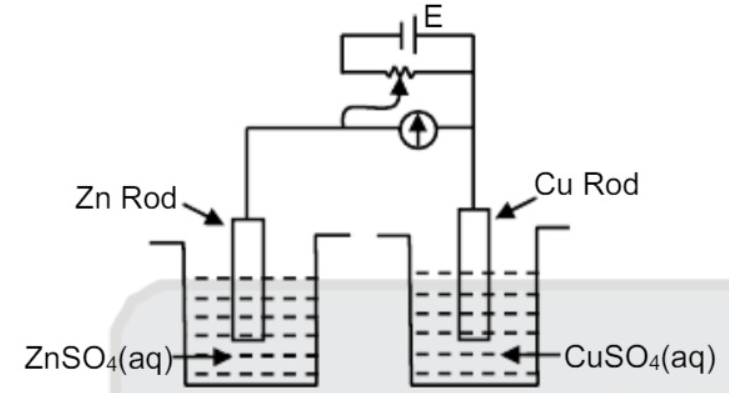Ec−.red of different half cell are given as :
Ec−.Cu2+∣Cu=0.34V,Ec−.Zn2+∣Zn=−0.76V.
Ec−.Ag⊕∣Ag=0.80V,Ec−.Mg2+∣Mg=−2.37V.
In which cell ΔGc− is most negative ?
Zn∣∣Zn2+(1M)∣∣∣∣Mg2+(1M)∣∣Mg
Zn∣∣Zn2+(1M)∣∣∣∣Ag⊕(1M)∣∣Ag
Cu∣∣Cu2+(1M)∣∣∣∣Ag⊕(1M)∣∣Ag
Ag∣∣Ag⊕(1M)∣∣∣∣Mg2+(1M)∣∣Mg
The correct Answer is:b
To determine which cell has the most negative ΔG, we can use the relationship between ΔG and the cell potential (E) given by the equation:
ΔG=−nFE
Where:
- ΔG is the change in Gibbs free energy,
- n is the number of moles of electrons transferred,
- F is Faraday's constant (approximately 96485 C/mol),
- E is the cell potential in volts.
To find the cell with the most negative ΔG, we need to calculate the cell potential (E) for each half-cell reaction and then determine which corresponds to the highest (most positive) E value.
1. Identify the half-reactions and their standard reduction potentials:
- E∘(Cu2+/Cu)=0.34V
- E∘(Zn2+/Zn)=−0.76V
- E∘(Ag+/Ag)=0.80V
- E∘(Mg2+/Mg)=−2.37V
2. Calculate the cell potential for each possible combination:
- Cell 1: Zn oxidized and Mg reduced
- E=E∘(Mg2+/Mg)−E∘(Zn2+/Zn)
- E=(−2.37)−(−0.76)=−2.37+0.76=−1.61V
- Cell 2: Zn oxidized and Ag reduced
- E=E∘(Ag+/Ag)−E∘(Zn2+/Zn)
- E=0.80−(−0.76)=0.80+0.76=1.56V
- Cell 3: Cu oxidized and Ag reduced
- E=E∘(Ag+/Ag)−E∘(Cu2+/Cu)
- E=0.80−0.34=0.46V
- Cell 4: Ag oxidized and Mg reduced
- E=E∘(Mg2+/Mg)−E∘(Ag+/Ag)
- E=(−2.37)−0.80=−3.17V
3. Determine ΔG for each cell:
- For Cell 1: ΔG=−nF(−1.61) (positive)
- For Cell 2: ΔG=−nF(1.56) (negative)
- For Cell 3: ΔG=−nF(0.46) (negative)
- For Cell 4: ΔG=−nF(−3.17) (positive)
4. Identify the cell with the most negative ΔG:
- The most negative ΔG corresponds to the cell with the highest positive E value.
- Cell 2 has the highest E value of 1.56 V, which means it has the most negative ΔG.
Conclusion:
The cell with the most negative ΔG is the one where Zn is oxidized and Ag is reduced.
- ΔG is the change in Gibbs free energy,
- n is the number of moles of electrons transferred,
- F is Faraday's constant (approximately 96485 C/mol),
- E is the cell potential in volts.
- E∘(Cu2+/Cu)=0.34V
- E∘(Zn2+/Zn)=−0.76V
- E∘(Ag+/Ag)=0.80V
- E∘(Mg2+/Mg)=−2.37V
- Cell 1: Zn oxidized and Mg reduced
- E=E∘(Mg2+/Mg)−E∘(Zn2+/Zn)
- E=(−2.37)−(−0.76)=−2.37+0.76=−1.61V
- E=E∘(Ag+/Ag)−E∘(Zn2+/Zn)
- E=0.80−(−0.76)=0.80+0.76=1.56V
- E=E∘(Ag+/Ag)−E∘(Cu2+/Cu)
- E=0.80−0.34=0.46V
- E=E∘(Mg2+/Mg)−E∘(Ag+/Ag)
- E=(−2.37)−0.80=−3.17V
- For Cell 1: ΔG=−nF(−1.61) (positive)
- For Cell 2: ΔG=−nF(1.56) (negative)
- For Cell 3: ΔG=−nF(0.46) (negative)
- For Cell 4: ΔG=−nF(−3.17) (positive)
- The most negative ΔG corresponds to the cell with the highest positive E value.
- Cell 2 has the highest E value of 1.56 V, which means it has the most negative ΔG.
The cell with the most negative ΔG is the one where Zn is oxidized and Ag is reduced.
Topper's Solved these Questions
- ELECTROCHEMISTRYBOOK - CENGAGE CHEMISTRY ENGLISHCHAPTER - ELECTROCHEMISTRYEXERCISE - Ex 3.2 (Objective)
26 Videos
- ELECTROCHEMISTRYBOOK - CENGAGE CHEMISTRY ENGLISHCHAPTER - ELECTROCHEMISTRYEXERCISE - Ex 3.3 (Objective)
10 Videos
- ELECTROCHEMISTRYBOOK - CENGAGE CHEMISTRY ENGLISHCHAPTER - ELECTROCHEMISTRYEXERCISE - Solved Examples(Electrolysis And Electrolytic Cells)
12 Videos
- D AND F BLOCK ELEMENTSBOOK - CENGAGE CHEMISTRY ENGLISHCHAPTER - D AND F BLOCK ELEMENTSEXERCISE - Archives Subjective
29 Videos
- GENERAL PRINCIPLES AND PROCESS OF ISOLATION OF ELEMENTSBOOK - CENGAGE CHEMISTRY ENGLISHCHAPTER - GENERAL PRINCIPLES AND PROCESS OF ISOLATION OF ELEMENTSEXERCISE - Archives (Subjective)
14 Videos
Similar Questions
E∘(SRP) of different half cell given
E∘Cu2+/Cu=0.34voltE∘Zn2+/Zn=−0.76voltE∘Ag+/Ag=0.8voltE∘Mg2+/Mg=−2.37volt
In which cell Δ∘ is most negative:-
View SolutionGivenEc−.Ag⊕∣Ag=+0.80V,<br>Ec−.Co2∣Co=−0.28V,Ec−.Cu2+∣Cu=+0.34V<br>Ec−.Zn2+∣Zn=−0.76V
Which metal will corrode fastest ?
View SolutionGiven :
Ec−.Ag⊕∣Ag=0.80V,Ec−.Mg2+∣Mg=−2.37V,
Ec−.Cu2+∣Cu=0.34V,Ec−.Hg2+∣Hg=0.79V
Which of the following statements is / are incorrect ?
View SolutionFor the given cell arrangement identify incorrect statement
given E∘_(Cu2+/Cu) = 0.34V &E∘_(Zn2+/Zn)=−0.76V
View SolutionGiven that E∘cu+2/cu=+0.34V
E∘Mg+2/Mg=−2.37V which of the following correct
View SolutionE∘Cu2+/Cu=0.34V
E∘Cu+/Cu=0.522V
E∘Cu2+/Cu+=
View SolutionE∘Cu2+/Cu=0.34V
E∘Cu+/Cu=0.522V
E∘Cu2+/Cu+=
View SolutionConsider the cell reaction :
Mg(s)+Cu2+(aq)→Cu(s)+Mg2+(aq)
If Ec−.Mg2+∣Mg(s) and Ec−.Cu2+∣Cu(s) are −2.37 and 0.34V, respectively. Ec−.cell is
View SolutionCalculate the maximum work that can be obtained from the decimolar Daniell cell at 25∘C.
Given Ec−.(Zn2+∣Zn)=−0.76V and Ec−.(Cu2+∣Cu)=0.34V
View SolutionCopper from copper sulphate solution can be displacesd by. (The standard reduction potentials of some electrodes are given below):
Eo(Fe2+/Fe)=−0.44V,Eo(Zn2+/Zn)=−0.76V
Eo(Cu2+/Cu)=+0.34V:Eo(Cr3+/Cr)=−0.74V
Eo(H+/12H2)=0.00V
View Solution
